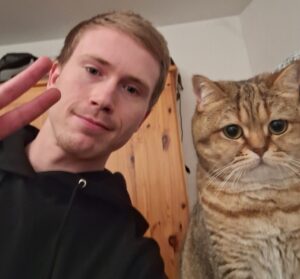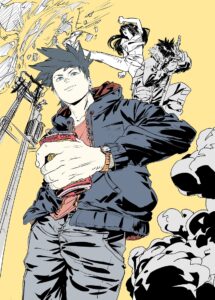- Chris says the idea to become an animator most likely came from watching Naruto
Amin Abbas
Christoph Thoenes (Chris), a talented German animator has worked on major Japanese animation projects such as: One Piece, One Punch Man (Season 2), Vinland Saga, Chainsaw Man and more.
Speaking exclusively to Arab News Japan, Chris shared his inspiration for animation: “I believe it was my big brother. Back then we used to watch a lot of anime shows when we were children! He also bought many manga all the time so I just read whatever he bought, of course there were shows included like Ranma 1/2, Naruto, One Piece, Dragonball, Inuyasha, Detective Conan, etc.
“I also have many sweet childhood memories with my friends and siblings. For example, when we used to stay over at my grandparent’s place, we would always watch shows like kickers, flint hammerhead etc. very early in the morning on their tv,” he added.

About the establishment of his career in the animation industry, Chris said: “I believe the first person who introduced me was probably a stick figure animator. But the idea to become an animator and animating my own scenes most likely came from watching Naruto. Norio Matsumoto’s work on ‘Naruto vs Sasuke’ battle on episode 133 in Naruto’s original anime series guided me to become an animator. It will forever stick with me and one day I want to animate a tribute to him with the best possible quality”.
“I just liked animating stuff that appeared fun to me. Motion is very fascinating and it is just cool seeing your ideas coming to life and how people feel entertained by it. You share good experiences through these few seconds of animation with everyone”.
“For my first project in animation, there are multiple commission works I can barely remember, but as for official studio productions, I worked with studio LAN on: One punch Man (Season 2), The Daily Life of the Immortal King, Vinland Saga, and many more,” he added.
About the challenges that he faced during his career, Chris said, “Just learning everything of the pipeline and getting enough information and aiming for the correct approach is challenging. It’s important to always communicate your problems and questions. It’s not always easy to work as a team, especially when you are working remotely from home.”
About the differences of animation style and working conditions between Japan and Western countries in his opinion, Chris said, “the work conditions and approaches are different from project to project depending on the team. Most people know that the Japanese pipelines have rough conditions and fairly low wages. I think for like 90 % of the projects that’s still the case… But this is only my estimate as an outsider who lives in Germany, so please do not use this personal estimate as official numbers.”
“Aside from that there are also many outsourced studios, that support basically every produced episode or movie you can imagine. Many might come from China, Malaysia, South Korea, Philippines, etc.. and are working for a very low price to do a very tedious and time-consuming tasks like Douga (cleanup and in-between). I would like to add that the west also outsources a lot to eastern studios.”

Many artists /animators have troubles negotiating and run in the risk to be exploited just so they can contribute to their favorite show or make their first appearance. Also, the baseline and standard prices are fairly low for Key – and cleanup animation. The Production committee is also complicated in the way budget is being distributed. The budget can create the space for good work conditions, because more money also means more time for the people to work. But to ensure quality you also need the right team and the right conditions. And this can be fairly hard nowadays with so many different projects in production”.
“In western productions the average payment of an animator is fairly high I would assume… But the living conditions might also be much more expensive depending on where you live. It is also very expensive to study animation in the west. The work culture in Japan is also much stricter… Many work all days of the week. There are many documentaries on this topic”.
“As for the animation/ art styles I would say the actual difference is in its origin and history. I think it’s more a cultural thing at this point, since western is well known for their comics and Japanese for manga. The animation styles come from adapting the source materials, but also your cultural and personal influences”.
“However, it depends on you what kind of animation/ art style you want to follow, and it doesn’t really matter where you live. I naively assume it is possible to learn any style if you put in the time and energy. There are many Japanese/Korean productions that actually adapted western source materials. Wit studio is currently producing ‘suicide squad’ for example and studio MIR produced ‘the Witcher movie’, avatar, etc.,” he added.
About the most anime project that he had so much fun working with, Chris said:” I had fun on most of the projects, but they were also very hard … I really enjoy working on One Piece! The staff is kind and always very patient with me. I’ll be forever grateful to Mr. Hayato Tokita, who is one of the production managers at Toei Animation!”.
Speaking of which animation director that he had most fun working with and gave him valuable tips and tricks in the animation industry, Chris said: “I don’t have a favorite, but here are the ones that come to my mind right away: I would like to take this opportunity to thank these animation directors for their patience, kindness and great overall advice. Masami Mori, Katsumi Ishizuka, Tatsuya Yoshihara, Toru Iwazawa, Hakuyu Go, Arifumi Imai, Yoshimichi Kameda, LAN, Shota Shigetsugu, shuu sugita, Ken Yamamoto, Moaang, Myoun, Shingo Yamashita, Chengxi Huan, Tu-yong ce, Midori Matsuda, Toshiyuki Inoue, Itsuki Tsuchigami, Tam Lu, Pebble, Alaine vu, Jay Lou (hero) and so many more…”.
“Basically, anyone who worked with me in the past. All of them helped me to understand certain things for myself,” he added.
Chris had never been top the Middle East region before, but he knows animators who have their roots from the region. He is very interested in learning more about the Middle East culture and researching about the Islam religion too.
Regarding his upcoming projects in the near future, Chris said:” I cannot tell on which studio productions I’m working on. As for personal projects, I want to create my own short film at some point, I have been postponing it for over 3 – 4 years now”.
About his recommendations for those who want to be an animation artist or working for animation projects, Chris said:” Take your time to research properly into the fundamentals of art and animation. In case you look for names on YouTube, I always highly recommend Modern Day James, Proko, Sinix Design, Toniko Pantoja, Kim Jung Gi, etc…”.
“English helps you to find most of the information out there. Look for communities, so you can find people who join you on learning. It will be more fun and you can also support each other. If you manage to consistently draw, you will eventually figure out in which direction you want to go. Chase your dreams, you’ll reach them faster by supporting and being patient with others and yourself. You never know what you can do, until you did it.”

